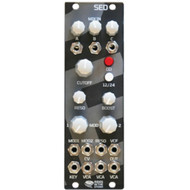SED - Rides in the Storm
by Ellison Wolf
Rides in the Storm makes feature-packed and great-sounding modules out of Berlin and is headed by Uwe George, who used to develop products at MFB and is half of IO Instruments, so it’s no surprise that RITS modules are well-designed. Their modules have a gray, understated look to them; and something else that’s understated is the description of their new SED module, as they call it a “High End Discrete Voltage Controlled VCF & VCF.” Maybe understated isn’t the right word, perhaps they’re just being modest because along with the VCF and VCA, this thing sports a three-channel mixer, and overdrive, all in 8 HP and for under $150 (US). The whole RITS line of modules is like this; gray, well-priced, and well-designed, and though I’m not 100% on the gray faceplates—like nearly everyone else I’m a fan of black—I still like the way they look and I’m rather fond of their knob choice.
The bulk of SED is based around its filter, a 4-pole 24dB/oct low pass type. There are all sorts of ways to change the character of the filter and it can get really cool and gnarly by adding overdrive via the Overdrive button, cranking the Resonance, and/or the Resonance Boost, which works to maintain your low end while the filter’s doing its magic. There are four CV inputs for modulation as well here, three for cutoff CV and one for resonance CV; Key (which is the 1V/Oct input), Resonance, Lin (for linear FM), and Env for envelope CV input. It was interesting to see how each input would affect the shape and sound of the filter, and it’s nice to be able to inject various flavors and speeds of modulation into the filter to combine them, just as cool as it is to mix three input signals into the filter and have it mix down to SED’s lone output. Patching in some fast-moving sawtooth LFOs—not quite audio rate—into the Env and Lin FM and this thing got nasty. Not to say this can’t be smooth and silky as well; it can and does it well, but I have other filters for that, and none that were quite like SED, with its combination of modulation inputs and sound.
I had a lot of fun playing with the filter with the resonance up high, just tweaking the Cutoff knob with the Boost cranked and the Overdrive on, using the Fundamental output of Xaoc Device’s Odessa patched into the input. The way it tracks reminds me of jazz sax/trumpet/etc. I’m sure that sounds odd, but it’s got a stepped pitchy feel, so that it’s stuttery and kind of twitchy when changing pitch and it really reminded me of some free jazz music (Miles Davis comes to mind), players blowing their horns, really on top of their game, producing abstract, wayward melodies and squawks. I tried this same effect and patch through other filters and couldn’t quite replicate the sensation I was achieving with the SED. It was more than the effect of just knob twisting; something was happening in the machine that had a real human performance vibe to it.
I also added a sequence coming from the Joranalogue Generate 3’s Full output into Input 1 of SED, and a slightly detuned instance of the same sequence coming out of a heavily modulated Expert Sleepers Lorelei VCO into Input 2 of SED, while throwing that same sequence into the Key (1V/Oct) Input of the SED with a slow-moving sine LFO modulating the Env of SED and it was awesome. Really, the envelope’s modulation of SED stole the show, going from buzzy but subtle filtering to laser-focused grit, but the movement and change of the filter with the various inputs…really gnarly stuff.
The Resonance and Resonance Boost work in tandem and it was interesting how changing one affected the other. Just as I would tweak the Cutoff while the filter was self-oscillating to change pitch, tweaking the Res/Res Boost interactively produced some interesting distortion. SED is a great howler (and whistling whiner, too), with way more flavor than one might expect from this. Riding the various controls in combination with modulation only added more spice, more options to sculpting the sound, and once I pushed the Overdrive button down it basically never came up. Why sound nice when you can sound…not so nice?!
The discrete VCA section consists of an Input, CV In, and Output. It’s at the bottom of the module and the filter’s output is normalled to it so that you can have two outputs of the filter if you want—the Filter out and the VCA out—and add elements of the filter’s inputs, like a different waveform output on a VCO feeding an input on the SED and combine to taste. The VCA is adaptable to various voltages and has a jumper on the flip side of the module that lets you choose 5V, 7.5V, or 10V CV input for it. There are so many options within this module it’s impossible to outline them all.
The only thing that nags a bit about SED is that the bigger knobs feel loose, not so solid. They are quality Alpha pots, and the module itself is of nice quality overall, but the pots are the plastic-stemmed type with slip-on knobs, which don’t give a sturdy, quality feel to them and I feel don’t live up to the rest of the module’s top quality build and design. I understand the price point and all of that, and again, this module is very well-priced, but I’d like to see a more burly pot.
That aside, I’m really impressed. SED is a killer module that I’ve had a ton of fun with and gotten a lot of intense sounds out of and I think we’re going to be seeing this one in a lot of racks. I’d search this one out for sure.
8 HP +12v 100mA -12v 100mA
Price: $145


